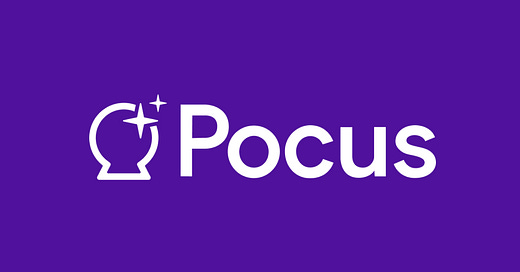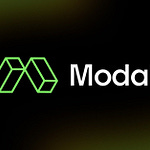VCs have been sounding the alarms, and everyone is wondering how to conserve cash. What decisions should you make in your go-to-market?
I explored these questions with Alexa Grabell, CEO & Founder of Pocus, who just announced her Series A from Coatue (and me!). We discussed topics such as:
What initiatives should you prioritize across your GTM?
How do you run a category creation / community motion in a low-cost way?
What do you do if you’ve already hired senior (i.e. highly paid) GTM leaders?
I hope you enjoy this conversation as much as I did, and feel free to reach out to me with any thoughts. Let's dive in!
If you’d like to hear more about topics related to scaling SaaS and other B2B businesses, you can subscribe to my newsletter (for free) here:
Leadership Roles
As always, I’ll share a few leadership roles at companies I’m excited about:
LaunchNotes: Director of Engineering
Kingdom Supercultures: Head of People
VendorPM:
Guide: Head of Marketing
Transcript
Allison: Alexa, thank you so much for joining us today. You and I have done a fair bit of content together in the past, and every time we find new topics to explore. So I'm really excited to have you back today.
Alexa: Thank you for having me, Allison. I love that we're both tuning in from Philadelphia right now [where we both grew up and where our extended families live].
Allison: Representing Philly! So today we're going to talk about, what do current market conditions mean for a company's go to market strategy, which is obviously a topic that's on many people's minds right now. I think you're going to have some very interesting insights into this. To start, can you just talk broadly about how would a potential recession impact go to market teams?
Alexa: Yeah, it's a great question. Stepping back a bit, maybe I can talk about my background, because then I think the thought process around product led growth and product led sales can inform how I think about the recession and those in the community that I've been communicating with recently.
Quickly, I'm the founder of Pocus, which is a product-led sales platform. We help sales and go-to-market teams at product-led-growth companies understand their data, to convert it into revenue. With a recession potentially coming soon, people are asking, What do we do about our go to market? If we are PLG, do we convert to sales led or vice versa? Should I be thinking about hybrid?
If I were to separate this into four different areas of impact for what go to market looks like, I would say there's an impact on leadership — leaders are saying, we need to take a hard look at our go to market metrics. We need to look at cost of customer acquisition, net dollar retention, revenue, what is the true health of the business? And we're moving from a time where it was about, “let's throw money and experiment and just grow as fast as we can” to “okay, let's be very thoughtful and have durable growth and profitability.”
The second area of impact would be sales team. There's been unfortunately a lot of chat about layoffs. It's taking over my LinkedIn right now. Companies are starting to think, if I have only a sales led motion, that means that the number of heads I have are directly correlated to revenue. But people want to get creative.
Third would be marketing teams. I think obviously there's going to be less budget for paid ads, marketing, and so folks will have to get really creative with organic channels — such as content and community.
Then finally, buyers. It’s going to be a tougher sell to get the money to actually make the purchase. They're going to have to see the value before that.
Allison: It seems pretty clear that if you pursue a product like growth strategy, probably you are going to be able to grow more efficiently. I think that's probably how most people think about PLG. Does that mean that if I'm not a PLG company, I should think about shifting into PLG?
Alexa: Definitely wouldn't say that's the rule. It depends. It could be the answer. It could not be. So I'm not saying that if you have a really strong sales led motion, it's time to flip the switch and just make a huge pivot and become product led.
Product led growth companies are saying, how do I remove any friction in the onboarding process? How do I activate customers? How do I reduce the need for humans in this process, so that buyers can realize the value without chatting with humans throughout the process?
If I were a sales-led company, maybe you do have the budget to experiment with freemium or free trial. Great. But my advice would be, put on your PLG thinking cap and think about, where can I eliminate friction and add product earlier in the user journey? I don't care if you call it product led growth. Just think about removing friction.
For example, I was just chatting with the CEO of really fast growing company. They're at the series D stage, and they have hypergrowth via a sales-led motion. And what we were talking about is, where is the lowest hanging fruit, where can he drive folks to the product, reduce friction, make things more automated. And we talked about the onboarding process. So after a free trial, what happens for them is they have a sales rep reach out and say, "Okay, your free trial is coming to an end. Do you want to chat about what the relationship can look like? Then I'll send you an invoice." That process — and I was actually on the receiving end of that process at one point — is for most of your customers, not necessary. If you have an SMB or mid-market customer, that could have been eliminated by just saying, "Swipe your credit card after the free trial," and have a sales assist person or product specialist reach out and say, "I'm here for you." And then maybe 10% of the customers that are more enterprise can have that call.
So look at those areas where you can take a step back and say, do we really need a human there? Or can this process be automated? If we don't need a human there, what's a better use of that person's time? And in my opinion, a better use of that person's time, instead of hopping on a 30-minute call with everyone who doesn't need to, is reaching out and saying, how can I help you? How can I add more value? And building that relationship.
Allison: If I am a more traditional sales-led company, and I'm looking to experiment with more of a hybrid model where I have some of these best practices of product led growth baked into my model of the future, what might be some experiments that I could run in order to adopt some PLG practices?
Alexa: Yeah, product led growth is just a series of hypotheses and experiments to test. So if you are lucky that you have some product touch points before the buying cycle, whether that is a free trial or a freemium product, instead of reaching out to every single customer that's on a free trial, an experiment you can run is to say, "We're going to take this subset of customers and see how much longer it takes them to convert from free to paid without a human touchpoint. And then how much does the human touchpoint actually pull forward the revenue?"
If the human touchpoint of a sales rep reaching out and getting on the phone, doing discovery and sending an invoice cuts down the sales cycle from, say, six months to six days, that's absolutely worth it to still have that. But what I would guess is in a lot of companies with a strong free trial and strong product led motion, where the product's really self explanatory and you can do a lot of creative things like email templates for onboarding and in-app onboarding experiments, then what you'll see is what's the difference between one month and two months? Does that actually matter? Or is that pulling your revenue forward just a month, is that worth it for that sales rep?
And are there other creative things we can do within the product — adding a Chrome extension, adding nudges, or adding a Drift campaign — that don't involve a sales person, but can actually bring revenue forward by that same amount?
It's a bunch of baby steps and experiments along the way to figure out what is possible for our organization, and how those changes impact the long term revenue numbers.
Allison: Let's say I'm already a product led sales company and, therefore, I'm probably doing things quite efficiently already. What should I do, given the potential recession, to protect my PLG motion?
Alexa: If you already have a product led sales motion, what that tells me is you are pretty data driven. You are tapping into your self serve existing users and trying to convert from a free trial to paid, or to find upsell and cross-sell opportunities.
The more that you can be data driven and use that data that's usually in places like your data warehouse to supercharge your go to market team, the more you're going to be able to close deals faster. And so what I actually mean by that is, there’s a lot of data that lives across your organization, around how your users are using your product: who's signing up, who's engaging with what features, are they sharing the product? Typically, that data lives in a data warehouse like Snowflake or Redshift or BigQuery.
The more that you can get sales teams and customer success teams access to that data, the better. For example, if you are an SDR, and you want the highest rate of getting on a call and finding a qualified opportunity, would you rather go after someone who's been on your product for six months and clearly loves the product and has shared it with many other folks? Or would you rather cold DM someone on LinkedIn? Statistically, the first option is better. So how do you find that data about who the good customer is? That's what's typically trapped in the data warehouse. So the more that companies can supercharge and give SDRs access to the data and let them analyze it and take action on it, the better.
This goes for various roles. So account managers — if they want to understand which of their accounts has an opportunity for upsell or cross-sell or expansion, instead of having several different discovery calls to figure out what teams might have an opportunity there to start using your product, or where you think that your existing users could benefit from a new module or a new product feature, look in your data. That can save you a ton of time in talking to the customers. I'm not saying you shouldn't talk to them, but you should be able to go into those conversations and say, "Hey, I noticed you're doing X, but not Y. Can I help you with Y?" Be as data driven as possible to customize the message to speed up that sales cycle.
Allison: Now, if I'm a PLS company, product led sales company, and I'm constrained in headcount, budget, or recruiting capacity, what roles should I prioritize across my go to market motion?
Alexa: It's a really good question, and it is different for every company. If you're really focused on new business, maybe you want to bring in some AEs. If you're focused on expanding existing relationships, maybe it's more in the customer success side.
In this market, it’s obviously going to be less expensive to expand existing customers versus find new business. And it's going to be more expensive to lose existing customers than to lose someone who was never a customer. How do I retain these existing customers and make them continuously happy, paying, and activated on our product? You would want to look at more of the post-sales roles or folks that can drive adoption, activation, and eventually renewal, upsell, and expansion.
If you have, for example, a bunch of self-serve users, and you are saying, how do I then convert those to paid, I would look at sales assist, product specialists, or onboarding specialists — these are all hybrid roles of SDR, support, and success. They’ll help users get the most value out of the product quicker, so that they convert to paid. Or if you are having trouble with expansion and renewals, then you could leverage a one-to-many CSM or digital scaled CSM group.
Look at your organization, figure out how to grow your business with the existing user base, and then find the areas of friction and where you need humans to be involved.
Allison: I know that you and your company have been amazing at building community, partly in service of category creation. I know a lot of companies are trying to pursue a category creation motion. That can be very expensive, which is obviously not a desirable thing in any case, but also particularly entering a potential downturn. So if I'm trying to be a category creator, I'm trying to build community around my ideas and my company, what's a low-cost way to do that?
Alexa: First, you should consider, do I need to create a new category? And do I want to put the resources toward this? Because like you said, it can be very expensive. It's a lot of work. So you need to only do it if you know the category doesn't already exist, and this is part of your long term strategy. This isn't just something to experiment with for the year. It's part of the entire growth of your organization.
You and I talked about this for a long time in several meetings, around why there needs to be this product led sales category. For us, particularly, it just didn't exist. It's a new sales motion, new type of role, new tech stack. And so we were very confident that this had to happen, and we felt a pull of the community with that.
I know that the experts all say category creation is expensive, but I think marketing in general is expensive. It's more a reallocation of where you want to spend your budget.
So for us, we built the Pocus community. We started this time last year with 20 people on a Slack channel, and our whole goal was quality over quantity — to add a lot of value, get experts in the room that are talking about product led sales, and bring people who are eager to learn, communicate, and debate. And then the community organically grew to now close to 1300 folks, who are all talking about product led sales. The conversations within the community are what then drove our content. Our content is what drove the category creation.
In this process, we've spent very, very little money on our community. It's really organic, all about leveraging and tapping community members to host an AMA, to facilitate a workshop, to make introductions when you know it will be a valuable relationship for both people’s companies. And then they start talking about product-led sales and how Pocus has helped them do it.
Actually, I think the first real dollar we're spending towards our community is in a couple weeks, when we're having our first in-person meet-up. If you want to build a category, ask yourself, how do I take this group of evangelists and help them get what's sitting in their brain on paper, facilitate the debate and the communication, and then continue to take that and run with it? Whether it's in meetups, whether it's in content — keep going from there. Rather than thinking, how can I take my budget and throw it all into community.
Allison: One of the questions that I'm getting from founders that I work with is how to preserve cash runway. In particular, I've had some founders who are very experienced, have amazing networks, and therefore have been able to build out pretty senior teams on the go to market side earlier in their company than probably most founders would. That's amazing in a lot of ways, but unfortunately, it means that their cost structure is higher maybe than is desirable. So if I'm a founder, thinking about where to keep senior leadership in a product-led sales company, where do you think those dollars are best applied?
Alexa: It's an interesting question, and I think it depends on the stage of the company. If I had, for example, an early founding team of go to market professionals that I thought were stellar, and I wanted to build and grow with them, but I knew that we didn't have the burn, then honestly I would have the conversation around changing their equity and cash comp split. You can talk about your cash balance and runway, and say that if you want to be on the team, this is the equity-cash split that makes sense now. And we can re-evaluate in a couple of months.
When you're at the seed A/B stage, those early leaders also have to be executors. They need to be willing to get in the weeds, try things, and do the job as an IC, as well as a manager, with the long term vision that they're going to grow the team. With our founding team, we had the conversation around, yes, you could be a manager and a leader and scale out this team, but for the first couple years, you're going to be an IC.
Allison: So you're thinking that actually people should perhaps be open to taking pay cuts in exchange for maybe greater equity?
Alexa: It depends. I'm thinking more of who you're going to hire. There are some hungry people that say, "Look, I believe in your company so, so, so much that I'm willing to do anything for it. And if I need to take a pay cut for the first year because of the conditions we're in and have it in exchange for equity that may be more in the long run, I'm willing to do it." Obviously, that's not everyone's situation, but I think that is often a really good indicator of someone who genuinely believes that this is going to be something huge in the future. I would hold onto them.
In terms of your existing employees, I think it depends. I think pay cuts would be tough. I think that there's a lot of different things that I would do. I would maybe have that conversation around the equity comp split. I would think about some folks who, if you say they're a great leader, but we might not need them for the next two years because we need someone more junior, maybe bring them on as an advisor and switch it to more equity than cash comp. There's probably a lot of creative things you can do.
I'll say if I find someone that is special and incredible, and I know they're going to be part of the Pocus journey forever, I will hold onto them regardless of what it takes and make both work. I don't believe in having to say “either, or.” I think of, “make the ‘and’ work.” So make us be able to have the runway and keep them around in some form.
Allison: I've heard that the cost of advertising may go up in the future. I don't know a ton about the subject, but given, for example, increasing privacy requirements, it might just be more difficult and more costly to reach your audience. And I'm wondering what that means for product led sales companies. I know you said earlier that, particularly entering a recession but also in general, it's good to have more of your leads coming from organic sources, less from paid ads. But I am curious, if I'm the kind of company that has a meaningful amount of my pipeline coming from paid ads, how should I think about what might be the future of the cost of advertising and how to allocate my spend?
Alexa: I would be interested to actually dive into the numbers here, but I'll tell you anecdotally what I observe. I think really good product led growth companies have a strong self-serve flywheel. In the early days, the leads may have come from paid advertising, but now it’s more about the virality and community effect that drives it. You need to start that flywheel so that the cost of acquiring every new customer goes way down.
I'm thinking of Notion, for example. It took them a couple years to get up and running, but then they started to recognize that there were a bunch of folks that were using Notion and getting paid to actually build Notion templates. And then they were actually ambassadors of Notion informally. So what did Notion do? They hired these ambassadors and said, keep spreading the word. Find new areas. Start a community in this region and this industry around how they can use Notion.
For good product led growth companies, they tap into product hacks and growth hacks in community more than just paid marketing. That's also how we run Pocus. It's all around community and content versus paid advertising.
Allison: That's really smart. One of the other concerns that I've heard circulated a lot in our industry is about tech companies that sell to other tech companies. In a way, this influx of capital over the past year has been self-referentially fueling tech companies' growth. You put more money to a tech company, then they sell to all your other portfolio companies, and then they're able to raise more money and sell to the other portfolio companies. It's a flywheel from there, which you could imagine crashing down when capital becomes more scarce. In particular, the tech industry has been affected more than other industries by the recent downturn, since when interest rates go up, it discounts future cash flows, which is really what the valuations of tech companies are largely based on, it's growth that's coming in the future.
Alexa: Totally.
Allison: So if I'm a tech company selling into other tech companies primarily, I might be a little concerned and eager to diversify. I'm wondering, especially how does this potential trend affect product led growth companies? I would think that tech people would be more likely to sign up for self-serve products than non-tech people. Although I don't know if that's the case, but I am curious just to know your perspective on, if I'm a PLG company, how should I think about this vertical segmentation of my customer base and how to evolve it over time?
Alexa: I'll answer the question first from the perspective of any tech company, and then I can narrow into product-led companies. For any software company — and I was just talking about this with my team — now is the time to not be a nice-to-have product. You must be a need-to-have product if you're going to sell into other B2B software companies. And so what I mean by that is there has to be such clear ROI on revenue generation or time saved.
That’s what we've been narrowing in on at Pocus. We are a revenue generating product for other companies, and we can save them time. So how can we show our customers that we are saving them 10 engineering heads for a big fraction of that cost?
For product led companies, I think that absolutely still applies. If you can play the long game of product led growth, and you have the capital, it's great to be able to take the time to build those self-serve fly wheels and become really embedded in organizations with that viral growth. A lot of the best PLG companies did this: they weren't charging a ton in the early days, because their goal was more around activation and adoption than revenue. I can think of a lot of our customers right now that are doing that. Then once the market is in better conditions, you can go in and have a really good story of, “We're now in every single one of your organization’s departments. We can roll this up into an enterprise license. And once we go from free to paid, you're going to be saving millions of dollars.”
I know that not everyone has that opportunity, but I do think a lot of well-funded PLG companies right now — which feels like a lot of companies — can play that game.
Allison: It seems like in general, a lot of companies are trying to move up market into enterprise in this moment. What are you noticing with the companies that you work with?
Alexa: I'm going to have a hot take. I think that's something that investors like to say. That's what we've seen in the past worked. What I think is, get creative with your go to market and do what works.
I was doing a lot of thinking about past recessions and where have people either shifted their product or their go to market motion, and there's proof that recessions and down markets can lead to breakthrough companies. You think of Airbnb and COVID, where everyone thought Airbnb was dead. I remember saying I'd never book an Airbnb again, but they just took all of their resources, and people allocated it towards long-term stay. And so what I mean is they got creative, they fixed it. They said, okay, we're going to have a different go to market and strategy. We're not going to do the one week Airbnbs. We're going to do the three month Airbnb.
And that's the same for every company. Maybe your strategy is, I don't want to be SMB self serve right now because I don't have the capital to play the long game of PLG and I want to go up market. Great, experiment with that. I would say be data driven, be personalized, make sure that you're constantly checking that that is working and that you're pulling revenue forward at a very faster rate than what you were doing before.
It depends for every company. I would just say, be very creative, diligent, and agile through the process.
Allison: All right, Alexa, this has been an awesome conversation. Any last tips for folks who are trying to manage their go to market through a potential downturn?
Alexa: It's a good question. I would say, just to repeat what I've said before, if you're product led, I would double down. If you're sale led, I would start thinking like a product led company, find ways to reduce friction, find ways to add value through automation versus humans, and just get creative. Instead of trying to throw a lot of heads at a problem, think through how you can optimize growth, activation, and onboarding with the fewest amount of resources.
Allison: Alexa, thank you so much for joining us today. This was great.
Alexa: Thank you for having me.












